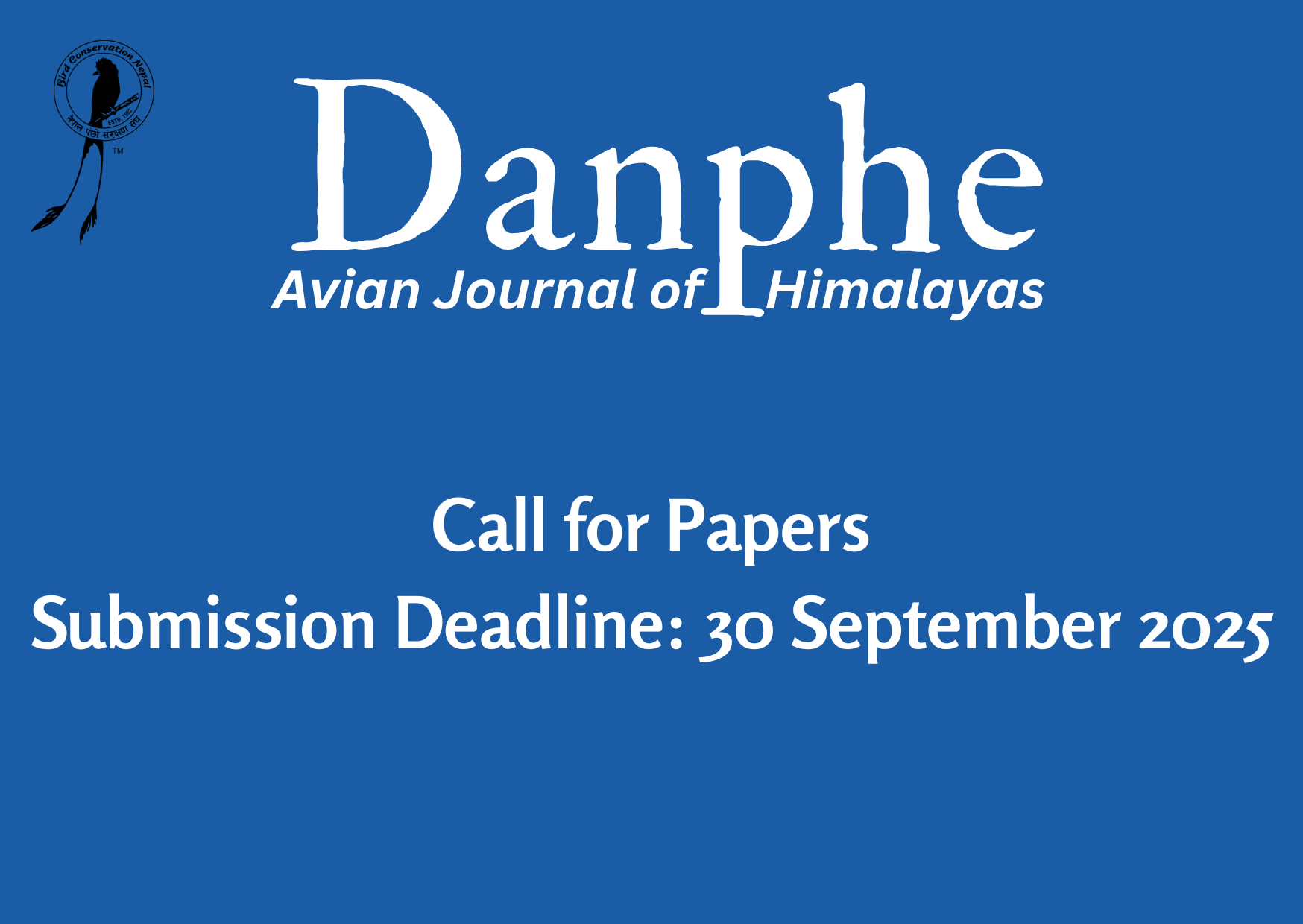
Danphe, a quarterly newsletter of Bird Conservation Nepal (BCN) has been published since 1992. Due to its long publication history, wide circulation, popularity among bird researchers on Nepal’s birds, BCN has set it as a biannual scientific journal that can cover multifaceted information on avian research and conservation activities of Nepal and the entire Himalayan regions covering from Afghanistan, Pakistan, China (Tibet), India, Nepal and Bhutan.
Aims and Scope
It
is a
peer-reviewed biannual (June & December) open access journal of scientific
research on birds of Himalayan regions. The mission of the journal is to
promote different facets of ornithological studies by encouraging researchers
across its scope to publish and share their research and scientific information
in an accessible form. It publishes checklists, habitat and distribution, taxonomic
discoveries, new records, biology, population studies, conservation, avian behavior
(e.g. nesting/feeding ecology, migration, foraging), review papers, illegal
bird trade, captive birds, short notes/communication, including conservation activities
and news. The information must be original work and have not been previously
published elsewhere. The full length articles ranges from 4000-6000 words. However
there is no page limit. Review papers and checklist might be longer based on
the area coverage.
Danphe is published both in hard copy and online. The Danphe invites original research papers from contributors. Please read the detailed submissions guidelines below before sending your manuscript. The following structure of the paper is for original articles which is not applied for review papers and checklists.
Submission Deadline: 30th September 2025
Submit your manuscript to : danphe@birdlifenepal.org
Publication Charge : There is no fee for submission, processing, or publication.
Structure of the paper
Title (less than 25 words)
Author(s) name (First, Middle, Last)
affiliation, email
Abstract (less than 200 words, concise and
informative focusing on author’s research findings)
Keywords (5-6 words, no repetition from title)
Introduction (background information on the topic
with pertinent reference citation, clear aim and justification with significance
of the study)
Materials and Methods
(Write a clear
description of sampling procedures, field studies and statistical procedures, give
the model number for equipment used)
Results (should be stated concisely, without
interpretation).
Discussion (Interpret your results, relate them to
the results of previous research, and discuss the implications of your results
or interpretations, compare and contrast your research with other findings)
Conclusion (provide the main conclusions of the
research and give a clear explanation of their importance and relevance)
Acknowledgements
References (should be in alphabetical order)
Instructions to
authors
Papers should
be in grammatically correct English. Scientific names of genera and species should
be italicized. While preparing the manuscript, type in Times New Roman (font
size 12pt, line spacing single, heading and subheading in bold without
numbering) in A4 size paper in a single column. Separate paragraphs with a
blank line. Figures, tables, and images will be published under a Creative
Commons CC-BY license, and permission must be obtained for use of
copyrighted material from other sources. Each figure/table/illustration must be
mentioned in the text in numerical order e.g. Figure 1., Figure 2., Table 1.,
Table 2.). If there are multiple figures/photographs arrange them in a single
plate by numbering A, B, C, D. High resolution images (JPEG, TIFF) will be
asked on the acceptance of the paper if required.
The arrangement
of the main text varies with different types of papers but should usually start
with an introduction and end with a list of references.
References should be cited in the text as “Bhusal (2018); Baral & Inskipp (2020);
Inskipp et al. (2020) (3 or more authors), or alternatively in a parenthesis (Bhusal
2018; Baral & Inskipp 2020; Inskipp et al. 2020). All literature cited in
the text must be listed in the references in the following format,
Journal paper
Inskipp, C.,
Baral, H.S., Acharya, S., Chaudhary H., Ghimire, M. & Giri, D. 2020. Rare
birds in Nepal. Nepalese Journal of Zoology 4(2):108–132. https://doi.org/10.3126/njz.v4i2.33894
Book Chapter
Baral, H.S.
& Inskipp, C. 2020. Birds of Nepal: Their status, and conservation
especially with regards to watershed perspectives. In: Regmi, G.R. & Huettmann, F. (Ed.), Hindu
Kush-Himalaya Watersheds Downhill: Landscape Ecology and Conservation Perspectives,
Springer Nature, Switzerland, pp.435-458.
Book
Grimmett, R.,
Inskipp, C., Inskipp, T., & Baral, H.S. 2016. Helm Field Guide. Birds
of Nepal (revised edition), Christopher Helm, Bloomsbury Publishing, London,
368 pp.
Internet
sources
BirdLife
International. 2024. State of the World's Birds 2024 Annual Update. Available
from https://datazone.birdlife.org/articles/state-of-the-worlds-birds-2024-annual-update,
(Accessed on 2025-07-19)
Thesis/Dissertation
Subedi, T.R.
2004. Distribution and diversity of diurnal raptorial birds in Shivapuri
National Park and adjoining areas, Central Department of Zoology, Tribhuvan
University, Kathmandu, Nepal.
Report
Bhusal, K.P. & Paudel, K. 2015. Ecological
monitoring and conservation of vultures in Jajarkot district, Nepal. A Report
submitted to Oriental Bird Club, United Kingdom, p.40.
Review process
After receiving
the manuscript first screening is done by the editorial board members and
returned to the author(s) if the standard the paper needs further improvement
before sending to the expert reviewers
The review
process involves the following steps:
- After the first screening by the
editorial board members, paper will be reviewed by two to three selected independent
expert reviewers to assess the scientific quality of the paper.
- Reviewer’s comments will be sent
to corresponding author to incorporate each and every comment.
- After receiving the final version
along with response from author, the publication committee send the file
to layout. The draft layout will be send to author for final correction.
- The review process normally takes
approximately 1 to 3 months depending upon the response of the reviewers.
Conflict of
interest
All authors
must disclose a conflict of interest (COI) in their contributions.
